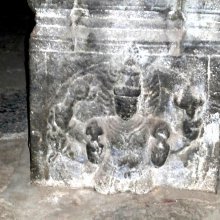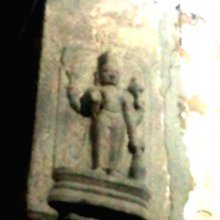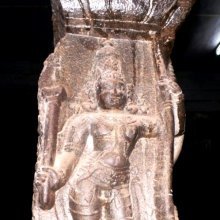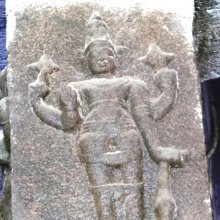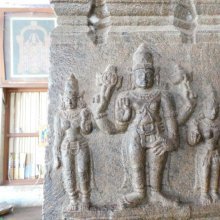Caturbhuja, Catur-bhuja, Caturbhujā: 23 definitions
Introduction:
Caturbhuja means something in Buddhism, Pali, Hinduism, Sanskrit, the history of ancient India, Marathi. If you want to know the exact meaning, history, etymology or English translation of this term then check out the descriptions on this page. Add your comment or reference to a book if you want to contribute to this summary article.
Alternative spellings of this word include Chaturbhuja.
Images (photo gallery)
(+62 more images available)
In Hinduism
Pancaratra (worship of Nārāyaṇa)
Source: SriMatham: Vaiṣṇava Iconology based on Pañcarātra ĀgamaCatur-bhuja (‘The four arms’): The four arms represent the three fundamental qualities (gunas) and thenotion of individuality (ahamkara) [from which all existence arises].

Pancaratra (पाञ्चरात्र, pāñcarātra) represents a tradition of Hinduism where Narayana is revered and worshipped. Closeley related to Vaishnavism, the Pancaratra literature includes various Agamas and tantras incorporating many Vaishnava philosophies.
Shilpashastra (iconography)
Source: Archaeological Survey of India: Śaiva monuments at Paṭṭadakal (śilpa)Caturbhuja (चतुर्भुज) is found as a sculpture at the temple of Lokeśvara, western half of the north wall, northern façade.—Standing statue of Śiva with four hands. There is no second gaṇa to the left of the god. Of his two lower hands the right one is damaged and the left is in kaṭyavalambita. The ornamentation of the images in both the niches is alike. Above the niche, in the effigy of a shrine, is carved Garuḍārūḍha Viṣṇu. Garuḍa is shown in flying pose, carrying his Lord Viṣṇu on his shoulders. The scene is in an ornately decorated sanctum with pillars and paraphernalia.

Shilpashastra (शिल्पशास्त्र, śilpaśāstra) represents the ancient Indian science (shastra) of creative arts (shilpa) such as sculpture, iconography and painting. Closely related to Vastushastra (architecture), they often share the same literature.
Purana and Itihasa (epic history)
Source: archive.org: Shiva Purana - English Translation1) Caturbhuja (चतुर्भुज) refers to “having four arms”, used to describe the appearance of Goddess Durgā, according to the Śivapurāṇa 2.2.11. Accordingly as Brahmā said to Nārada:—“[...] O celestial sage, on being thus lauded Caṇḍikā, the mystic slumber, appeared before me. Her complexion had the glossy hue of collyrium. She had comely features. She had four divine arms (divya-caturbhuja). She was seated on a lion. She showed the mystic gesture of granting boons by one of her hands, and pearls adorned her dishevelled hair”.
2) Caturbhuja (चतुर्भुज) refers to “one who has four arms” which is used to describe the appearance of Śiva, according to the Śivapurāṇa 2.2.17. Accordingly as Brahmā narrated to Nārada:—“[...] When her Nandā rites were concluded on the ninth day (Navamī), while she was engrossed in meditation, Śiva became visible to her. [...] He was in a joyous mood. He had four arms (caturbhuja) and His neck was blue in colour. [...]”.
3) Caturbhuja (चतुर्भुज) or “four-armed one” is also used as an epithet for Viṣṇu, according to the Śivapurāṇa 2.2.36. Accordingly:—“[...] On hearing these words of the sages Viṣṇu, desirous of fighting with Vīrabhadra went ahead. The powerful Viṣṇu, the four-armed (i.e., caturbhuja) discus-bearing Viṣṇu, fully equipped, came out of the sacrificial chamber along with the Devas”.

The Purana (पुराण, purāṇas) refers to Sanskrit literature preserving ancient India’s vast cultural history, including historical legends, religious ceremonies, various arts and sciences. The eighteen mahapuranas total over 400,000 shlokas (metrical couplets) and date to at least several centuries BCE.
Ayurveda (science of life)
Rasashastra (Alchemy and Herbo-Mineral preparations)
Source: Wisdom Library: Rasa-śāstraCaturbhuja (चतुर्भुज) or Caturbhujarasa is the name of a Ayurvedic recipe defined in the fifth volume of the Rasajalanidhi (chapter 24, Apasmara: epilepsy). These remedies are classified as Iatrochemistry and form part of the ancient Indian science known as Rasaśāstra (medical alchemy). However, since it is an ayurveda treatment it should be taken with caution and in accordance with rules laid down in the texts.
Accordingly, when using such recipes (e.g., caturbhuja-rasa): “the minerals (uparasa), poisons (viṣa), and other drugs (except herbs), referred to as ingredients of medicines, are to be duly purified and incinerated, as the case may be, in accordance with the processes laid out in the texts.” (see introduction to Iatro chemical medicines)

Āyurveda (आयुर्वेद, ayurveda) is a branch of Indian science dealing with medicine, herbalism, taxology, anatomy, surgery, alchemy and related topics. Traditional practice of Āyurveda in ancient India dates back to at least the first millenium BC. Literature is commonly written in Sanskrit using various poetic metres.
Shaktism (Shakta philosophy)
Source: Google Books: ManthanabhairavatantramCaturbhujā (चतुर्भुजा) refers to “she who has four arms”, according to the Śrīmatottara-tantra, an expansion of the Kubjikāmatatantra: the earliest popular and most authoritative Tantra of the Kubjikā cult.—Accordingly, “(The adept) should meditate on the goddess Parāparā in the middle of the triangle. (Parāparā) shines with the light of the rising sun and is (red) like a pomegranate flower. She wears red clothes and is adorned with dreadlocks and the moon. Three wrinkles and a line of hair (adorn the middle of her body). She is replete with all fine characteristics and has fat upraised breasts. Tranquil and supreme, she has four arms [i.e., caturbhujā] and one face with three eyes. [...]”.

Shakta (शाक्त, śākta) or Shaktism (śāktism) represents a tradition of Hinduism where the Goddess (Devi) is revered and worshipped. Shakta literature includes a range of scriptures, including various Agamas and Tantras, although its roots may be traced back to the Vedas.
Ganitashastra (Mathematics and Algebra)
Source: archive.org: Science And Technology In Medievel India (Math)Caturbhuja (चतुर्भुज) refers to a “quadrangle” as described in the Kṣetragaṇitaśāstra, as mentioned in A. Rahman’s Science and Technology in Medievel India: A bibliography of source materials in Sanskrit, Arabic and Persian.—Ancient and medieval India produced a wide range of scientific manuscripts and major contributions lie in the field of medicine, astronomy and mathematics, besides covering encyclopedic glossaries and technical dictionaries.—The Kṣetragaṇita-śāstra is a Sanskrit mathematical treatise dealing with the art of measuring lands, containing well-defined and established technical terms [e.g., Caturbhuja] wanted for practical use in the Tamil language.

Ganitashastra (शिल्पशास्त्र, gaṇitaśāstra) refers to the ancient Indian science of mathematics, algebra, number theory, arithmetic, etc. Closely allied with astronomy, both were commonly taught and studied in universities, even since the 1st millennium BCE. Ganita-shastra also includes ritualistic math-books such as the Shulba-sutras.
Shaivism (Shaiva philosophy)
Source: SOAS University of London: Protective Rites in the Netra TantraCaturbhuja (चतुर्भुज) refers to a “four-armed deity”, according to the Netratantra of Kṣemarāja: a Śaiva text from the 9th century in which Śiva (Bhairava) teaches Pārvatī topics such as metaphysics, cosmology, and soteriology.—Accordingly, [verse 3.17-23, while describing a meditation on Amṛteśa in his form as Mṛtyujit]—“And so now, having constructed the amṛtāmudrā or the padmamudrā, [the Mantrin] should meditate on the Ātman. [...] [He is] one-faced, three-eyed, seated on a white lotus, fixed in the bound lotus seat. [He is] four-armed (caturbhuja), large-eyed, the hand [fixed in the position] of granting wishes and safety, [holding] a full moon, radiant, filled with amṛta, holding a water pot, [and] completely full of the world, the moon in his lovely hand. [The Mantrin] should remember him adorned with a reverence that is all white”.
Caturbhujā (चतुर्भुजा) or “four-armed” is also used to describe the Devīs associated with Tumburu (verse 11.1-24ab); Sūrya (verse 13.17-25ab); Viśvakarman (verse 13.25cd-28); Rudra and Brahmā (verse 13.29-36).

Shaiva (शैव, śaiva) or Shaivism (śaivism) represents a tradition of Hinduism worshiping Shiva as the supreme being. Closely related to Shaktism, Shaiva literature includes a range of scriptures, including Tantras, while the root of this tradition may be traced back to the ancient Vedas.
In Buddhism
Tibetan Buddhism (Vajrayana or tantric Buddhism)
Source: Wisdom Library: Tibetan BuddhismCaturbhuja (चतुर्भुज) is the name of Vidyārāja (i.e., “wisdom king”) mentioned as attending the teachings in the 6th century Mañjuśrīmūlakalpa: one of the largest Kriyā Tantras devoted to Mañjuśrī (the Bodhisattva of wisdom) representing an encyclopedia of knowledge primarily concerned with ritualistic elements in Buddhism. The teachings in this text originate from Mañjuśrī and were taught to and by Buddha Śākyamuni in the presence of a large audience (including Caturbhuja).
Source: archive.org: The Indian Buddhist IconographyCaturbhuja (चतुर्भुज) or Caturbhuja-Sitatārā refers to a deity from the White Tārā family, according to Buddhist Iconography.—Her [viz., Caturbhuja-Sitatārā] form has already been described as an emanation of the Dhyāni Buddha Amoghasiddhi. She has four arms and exhibits in the first pair of hands the Utpalamudrā, and the lotus, and the Varada pose in the second. She may be recognized by the presence of two goddesses, Mahāmāyūrī and Mārīcī. [...] Strictly speaking, only those deities can be called Tārās to whom the mantra: “oṃ tārā tuttāre ture svāhā” is assigned. [...] From the colour of the different Tārās it will be possible to refer them [viz., Caturbhuja] to their respective Kulas or families presided over by the five Dhyāni Buddhas.
Source: MDPI Books: The Ocean of HeroesCaturbhujā (चतुर्भुजा) refers to “she who has four arms”, according to the 10th-century Ḍākārṇava-tantra: one of the last Tibetan Tantric scriptures belonging to the Buddhist Saṃvara tradition consisting of 51 chapters.—Accordingly, [while describing the Adamantine Circle (vajracakra)]: “ [Every] Yoginī on all [twelve] circles—she [has] four arms (caturbhujā), [has] one face, holds a skull bowl and a skull staff [in the two left hands], also [holds] a small drum and a knife [in the two right hands], [has her] hair untied, is naked, [has her] body [ornamented with] the five seals, is adorned with a string of vajras, stands on a corpse, and is very terrifying; [she] wears various [good] ornaments and is a wisdom accompanying a means (her male consort). [...]”.

Tibetan Buddhism includes schools such as Nyingma, Kadampa, Kagyu and Gelug. Their primary canon of literature is divided in two broad categories: The Kangyur, which consists of Buddha’s words, and the Tengyur, which includes commentaries from various sources. Esotericism and tantra techniques (vajrayāna) are collected indepently.
India history and geography
Source: Shodhganga: a concise history of Sanskrit Chanda literature (history)1) Caturbhuja (चतुर्भुज) is the father of Rudraṇa and the great-great-grand-father of Kumāramaṇi (1703 C.E.): an author of prosody who belonged to the family of Harivaṃśa, was the son of Harivallabha, grandson of Kaṇṭhamaṇi, and great grandson of Rudraṇa, great great grandson of Caturbhuja. Kumāramaṇi was also the cousin of Vedamaṇi and elder brother of Vāsudeva. He belonged to Śrīvatsagotra. He was also the disciple of Jayagovinda Vājapeyi and Puruṣottama Vājapeyi (both brothers), Kavicārāḍana, Mādhavapaṇḍitarāja, Rudraṇa (probably his great grand father), Madhusūdanakavipaṇḍita. Kumāramaṇi mentions about his family and preceptors in the beginning of his work.
2) Caturbhuja (चतुर्भुज) is the son of Dāmodara and the father of Keśavācārya and the grandfather of Dhīreśvarācārya (1851-1919 C.E.): a poet of modern Assam who composed Vṛttamañjarī. Dhīreśvarācārya belonged to Tripravara-Bharadvājagotra and was the son of Keśavācārya alias Ātmārāma and Candraprabhādevī, grandson of Caturbhuja and great grandson of Dāmodara. Dhīreśvarācārya learnt the systems of grammar at the age of 12 from Rāmadevopādhyā of Nagarakuchi.

The history of India traces the identification of countries, villages, towns and other regions of India, as well as mythology, zoology, royal dynasties, rulers, tribes, local festivities and traditions and regional languages. Ancient India enjoyed religious freedom and encourages the path of Dharma, a concept common to Buddhism, Hinduism, and Jainism.
Languages of India and abroad
Marathi-English dictionary
Source: DDSA: The Molesworth Marathi and English Dictionarycaturbhuja (चतुर्भुज).—a (S) Four-armed, an epithet or a name of viṣṇu. 2 Having four sides or faces. 3 fig. Having the arms tied behind. v kara, hō. 4 fig. Having a wife.
Source: DDSA: The Aryabhusan school dictionary, Marathi-Englishcaturbhuja (चतुर्भुज).—a Four-armed. Having the arms tied behind. v Having a wife.
--- OR ---
caturbhuja (चतुर्भुज).—m A square.
Marathi is an Indo-European language having over 70 million native speakers people in (predominantly) Maharashtra India. Marathi, like many other Indo-Aryan languages, evolved from early forms of Prakrit, which itself is a subset of Sanskrit, one of the most ancient languages of the world.
Sanskrit dictionary
Source: DDSA: The practical Sanskrit-English dictionaryCaturbhuja (चतुर्भुज).—a. 1 quadrangular.
2) having four arms; Bhagavadgītā (Bombay) 11.46. (-jaḥ) 1 an epithet of Viṣṇu; R.16.3.
2) a quadrangular figure.
3) square.
-jam a square.
Caturbhuja is a Sanskrit compound consisting of the terms catur and bhuja (भुज).
Source: Cologne Digital Sanskrit Dictionaries: Shabda-Sagara Sanskrit-English DictionaryCaturbhuja (चतुर्भुज).—m.
(-jaḥ) 1. A name of Vishnu 2. An equilateral tetragon. E. catur four, and bhuja an arm.
Source: Cologne Digital Sanskrit Dictionaries: Benfey Sanskrit-English DictionaryCaturbhuja (चतुर्भुज).—I. four arms, [Bhāgavata-Purāṇa, (ed. Burnouf.)] 6, 1, 35. Ii. adj., f. jā, having four arms, 4, 12, 20. Iii. m. the name of a Dānava, [Harivaṃśa, (ed. Calc.)] 12934.
Caturbhuja is a Sanskrit compound consisting of the terms catur and bhuja (भुज).
Source: Cologne Digital Sanskrit Dictionaries: Cappeller Sanskrit-English DictionaryCaturbhuja (चतुर्भुज).—[adjective] = caturbāhu, [masculine] [Epithet] of [several] gods.
Source: Cologne Digital Sanskrit Dictionaries: Aufrecht Catalogus Catalogorum1) Caturbhuja (चतुर्भुज) as mentioned in Aufrecht’s Catalogus Catalogorum:—guru of Rāmānanda (Kāśīkhaṇḍaṭīkā). Oxf. 72^a.
2) Caturbhuja (चतुर्भुज):—father of the lexicographer Śivadatta (1677). Oxf. 195^a.
3) Caturbhuja (चतुर्भुज):—Adbhutasāgarasāra jy. L. 1930.
4) Caturbhuja (चतुर्भुज):—Aṣṭādaśa Saṃskāraḥ. Poona. 284. Āśauśasaṃgraha. L. 2071. Oudh. Xviii, 48.
5) Caturbhuja (चतुर्भुज):—Sṛṣṭikaraṇaṭīkā jy. Peters. 2, 195.
6) Caturbhuja (चतुर्भुज):—grammarian. Often quoted by Ramānātha in Manoramā.
7) Caturbhuja (चतुर्भुज):—Rāmanityārcanapaddhati.
8) Caturbhuja (चतुर्भुज):—Kṛṣṇapaddhati.
9) Caturbhuja (चतुर्भुज):—Śrutabodhaṭīkā Padadyotanikā.
10) Caturbhuja (चतुर्भुज):—composed in 1493 at Rāmakeli, a suburb of Gauḍa: Haricarita kāvya.
11) Caturbhuja (चतुर्भुज):—son of Bhavānīcaraṇa: Bhāgavatapurāṇadaśamaskandhakatipayaślokavicāra.
Source: Cologne Digital Sanskrit Dictionaries: Monier-Williams Sanskrit-English Dictionary1) Caturbhuja (चतुर्भुज):—[=catur-bhuja] [from catur > catasṛ] (in [compound]) 4 arms, [Bhāgavata-purāṇa iv, vi]
2) [v.s. ...] mf(ā)n. four-armed, [Mahābhārata iii, 16424; Rāmāyaṇa i; Bhāgavata-purāṇa iv]
3) [v.s. ...] quadrangular
4) [v.s. ...] m. Viṣṇu or Kṛṣṇa (cf. [Bhagavad-gītā xi, 46]), [Rāmāyaṇa vi; Raghuvaṃśa; Pañcatantra; Bhāgavata-purāṇa i]
5) [v.s. ...] Name of Gaṇeśa, [Demetrius Galanos’s Lexiko: sanskritikes, anglikes, hellenikes]
6) [v.s. ...] a quadrangular figure
7) [v.s. ...] Name of a Dānava, [Harivaṃśa 12934]
8) [v.s. ...] of the instructor of (the author of a [commentator or commentary] on [Skanda-purāṇa]) Rāmānanda
9) [v.s. ...] of the father of Śiva-datta
Source: Cologne Digital Sanskrit Dictionaries: Yates Sanskrit-English DictionaryCaturbhuja (चतुर्भुज):—[catur-bhuja] (jaḥ) 1. m. Vishnu.
[Sanskrit to German]
Sanskrit, also spelled संस्कृतम् (saṃskṛtam), is an ancient language of India commonly seen as the grandmother of the Indo-European language family (even English!). Closely allied with Prakrit and Pali, Sanskrit is more exhaustive in both grammar and terms and has the most extensive collection of literature in the world, greatly surpassing its sister-languages Greek and Latin.
Kannada-English dictionary
Source: Alar: Kannada-English corpusCaturbhuja (ಚತುರ್ಭುಜ):—
1) [noun] (pl.) four arms (as of a deity).
2) [noun] he who has four arms (as a deity).
3) [noun] Viṣṇu.
4) [noun] (fig.) a married man.
Kannada is a Dravidian language (as opposed to the Indo-European language family) mainly spoken in the southwestern region of India.
See also (Relevant definitions)
Partial matches: Bhuja, Catur.
Starts with: Caturbhuja acarya, Caturbhuja aupamanyava, Caturbhuja bhattacarya, Caturbhuja mishra, Caturbhuja pandita, Caturbhujabhattacarya, Caturbhujadasa, Caturbhujamishra, Caturbhujamishra aupamanyava, Caturbhujarasa.
Ends with: Ayatacaturbhuja, Mishracaturbhuja, Samacaturbhuja, Samakarnatulyacaturbhuja, Samalamba-caturbhuja, Samalambacaturbhuja, Samanantara-caturbhuja, Tulyacaturbhuja, Vishamacaturbhuja, Vishamakarnatulyacaturbhuja.
Full-text (+58): Caturbhuji, Vishamacaturbhuja, Samacaturbhuja, Caturbhujabhattacarya, Caturbhujamishra, Mishracaturbhuja, Vrittakautuka, Caturbhuja bhattacarya, Rasakalpadruma, Caturbhuja aupamanyava, Ramanityarcanapaddhati, Srishtikaranatika, Rasahridaya, Kathakaumudi, Caturbhuja pandita, Tattvacintamanididhitivistara, Krishnapaddhati, Samaanaantar-chaturbhuj, Caturbhuja mishra, Haricarita.
Relevant text
Search found 24 books and stories containing Caturbhuja, Catur-bhuja, Catur-bhujā, Caturbhujā; (plurals include: Caturbhujas, bhujas, bhujās, Caturbhujās). You can also click to the full overview containing English textual excerpts. Below are direct links for the most relevant articles:
Sahitya-kaumudi by Baladeva Vidyabhushana (by Gaurapada Dāsa)
Text 11.40 [Parikarāṅkura] < [Chapter 11 - Additional Ornaments]
Text 4.66 < [Chapter 4 - First-rate Poetry]
Śrī Kṛṣṇa-vijaya (by Śrī Gunaraja Khan)
Garga Samhita (English) (by Danavir Goswami)
Verse 4.19.91 < [Chapter 19 - A Thousand Names of Srī Yamunā]
Verse 6.19.38 < [Chapter 19 - In the First Fortress of Dvārakā, the Glories of Līlā-sarovara, etc.]
Verse 8.13.43 < [Chapter 13 - A Thousand Names of Lord Balarāma]
Chaitanya Bhagavata (by Bhumipati Dāsa)
Verse 1.1.133 < [Chapter 1 - Summary of Lord Gaura’s Pastimes]
Verse 2.8.64 < [Chapter 8 - The Manifestation of Opulences]
Verse 2.260 < [Chapter 2 - The Lord’s Manifestation at the House of Śrīvāsa and the Inauguration of Saṅkīrtana]
Bhakti-rasamrta-sindhu (by Śrīla Rūpa Gosvāmī)
Verse 1.2.105 < [Part 2 - Devotional Service in Practice (sādhana-bhakti)]
Verse 3.1.8 < [Part 1 - Neutral Love of God (śānta-rasa)]
Related products

